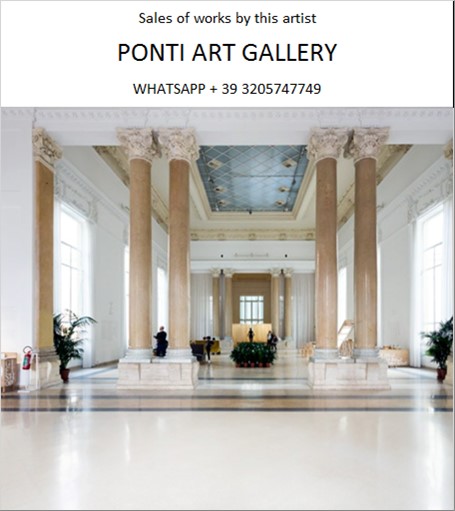Ponti Art Gallery is interested in buying and selling works
of art by this artist.

Friedensreich Hundertwasser
Biography
Friedensreich Hundertwasser, born Friedrich Stowasser on December 15, 1928, in Vienna, Austria, was a visionary artist whose work transcended the conventional boundaries of painting, architecture, and environmental activism. His pseudonym, which he adopted in 1949, is a reflection of his values and his artistic identity: "Friedensreich" meaning "peaceful realm" or "rich in peace," and "Hundertwasser" being a translation of the Slavic "sto" (one hundred) into German, thus "hundred waters." His additional self-given names, "Regentag" and "Dunkelbunt," translate to "Rainy Day" and "Darkly Multi-Colored," respectively, further encapsulating his colorful persona and approach to life and art.
Hundertwasser's early life was marked by the turmoil of World War II. His Jewish heritage, from his mother's side, forced him and his mother to pose as Christians to avoid persecution by the Nazis. His father, who was Catholic, had died when Hundertwasser was just a baby. The family's survival strategy included Hundertwasser's baptism as a Catholic in 1935 and his membership in the Hitler Youth, a harrowing experience that would later influence his passionate advocacy for individualism and ecological harmony.
Despite these early challenges, Hundertwasser developed a keen interest in art. After the war, he briefly attended the Academy of Fine Arts in Vienna but left after three months, feeling uninspired by the instruction. Instead, he found his muse through extensive travel and exposure to various cultures and artistic movements. His journeys took him across Europe and North Africa, and later to Japan, Nepal, Siberia, and the United States, among other destinations. These experiences enriched his artistic vocabulary and reinforced his commitment to a life in harmony with nature.
Hundertwasser's art is characterized by vibrant colors, organic forms, and a profound rejection of the straight line, which he saw as unnatural and a symbol of oppression. He was influenced by the art nouveau movement and the works of Egon Schiele and Walter Kampmann. His unique style incorporated elements of surrealism, expressionism, and what he termed "transautomatism," a focus on the viewer's experience and interpretation of art. Hundertwasser's paintings often featured spirals, which he considered a symbol of life and infinity, and his use of uneven textures and inclusion of natural materials broke the mold of traditional painting techniques.
In the 1950s, Hundertwasser's art gained recognition with exhibitions in Vienna and Paris. His success as an artist was paralleled by his architectural endeavors, which began in earnest in the 1970s. Hundertwasser's architectural philosophy was rooted in the belief that human beings should live in harmony with nature. He advocated for "tree tenants" and "window rights," where residents could extend their living space into the environment. His architectural works, such as the Hundertwasserhaus in Vienna, are celebrated for their imaginative vitality, colorful facades, and organic forms, including undulating floors and rooftop gardens.
Hundertwasser's commitment to environmental protection was unwavering. He engaged in various environmental campaigns, designed eco-friendly buildings, and promoted the use of renewable energy. His ecological footprint extended to New Zealand, where he spent significant time and became a citizen in 1983. There, he continued his environmental activism, planting thousands of trees and living self-sufficiently.
Throughout his life, Hundertwasser also engaged in applied art, creating designs for flags, stamps, coins, and posters. His work in this field was not only aesthetically pleasing but also carried messages of peace and environmental consciousness. He was a prolific writer and speaker, using his platform to advocate for a more humane and ecologically responsible society.
Hundertwasser's influence extended beyond the visual arts. He was a philosopher and an activist, challenging societal norms and advocating for a life that was free from the constraints of conventional aesthetics and destructive environmental practices. His manifestos and public appearances, sometimes performed in the nude to symbolize transparency and vulnerability, were both provocative and enlightening.
Friedensreich Hundertwasser passed away on February 19, 2000, aboard the Queen Elizabeth 2. His legacy is a testament to a life dedicated to the fusion of art, architecture, and environmental activism. His work continues to inspire those who seek a harmonious coexistence with the natural world and a more colorful, vibrant approach to life.
Friedensreich Hundertwasser
Quotes and Sales of Works
Ponti Art Gallery selects and deals with paintings by the
artist. Upon request, we provide free estimates and
evaluations, communicate prices, quotations, and current
market values.
If you are interested in BUYING or SELLING works by the
artist, contact us immediately.
If you wish to sell or receive an evaluation of the
works:
Send us a frontal photo of the painting, one of the back,
and one of the signature. Also, indicate the dimensions of
the work. Inform us about the purchase origin of the work
and any kind of available documentation (purchase
receipts, certificates of authenticity, publications). One
of our operators will respond to you on the same day. We
guarantee maximum confidentiality and extreme
professionalism.
If you wish to purchase works by the painter: Contact us
and let us know your request. We will inform you about the
available works. We also offer the possibility to
subscribe to our NEWSLETTER, through which you will be
informed at the beginning of each month about the latest
acquisitions of the art gallery.
You can send us pictures of the work:
